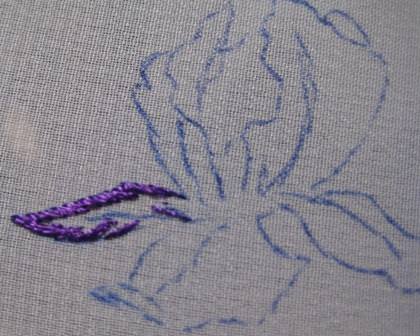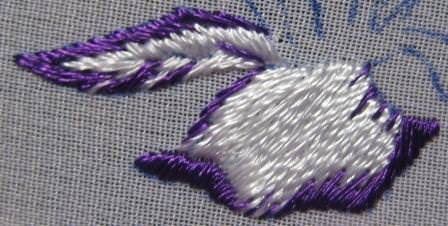
Flowers embroidery smooth schemes and a master class
Content
- How to embroider flowers smoothly
- Embroidery with iris flower
- Color schemes
- Video: Learning to embroider flowers smoothly
- one of the most common techniques of needlework. The popularity of this method is due to the fact that the compositions created by such a device are characterized by incredible realism and colorfulness. A special place in this work is occupied by flowers, the technology of embroidery which we will consider in today's lesson.





How to embroider flowers smoothly

The essence of the process is to create stitchesOf the same size. A contour of the flower is made on the fabric, which is completely sewn with small stitches. Threads are located tightly to each other and completely cover the pattern. There is no set amount of stitches. Their size directly depends on the embroidered composition. The slope can also be very different. The effect of the image depends on the arrangement of the strings.
Flowers are more complex than cross, but drawings,Created by this method, are more elegant. In this way it is possible to transfer the smallest schemes. For beginner needlewomen, ready-made simple schemes are better suited. More experienced masters do without them. We offer a small master class on embroidering a flower smoothly.
Embroidery with iris flower
Beautiful flowers in nature, they will look no less effectively on a tablecloth or pillowcase. You can embroider only cups with petals, and you can add stems with leaves.
To work required:
- the cloth;
- the hoop;
- needle;
- scissors;
- thimble;
- Threads of orange, light purple, dark purple and green flowers.
Manufacturing process:

Scheme for embroidery of iris smooth.The contour of the proposed scheme is transferred to the tissue. You can do this with a conventional pen. Also, a clear figure will be obtained if you use a carbon paper, tracing paper, a thermoconductive pencil.
As for the choice of fabric, everything here is on your owndiscretion. If you use chiffon, then there will be no problems with the translation of the image at all. In case of embroidery on knitted fabrics, it is recommended to use non-woven fabrics.
After that, the fabric should be pulled on the frame and fastened. This is one of the main nuances of good work. Since a poorly stretched material will cause a deformation of the pattern.
The choice of thread is also very important. The most common materials for embroidery on the face are the mulina. But flowers embroidered with silk have a more beautiful appearance and special iridescent shades. 4. The needle is selected according to the thickness of the thread. The main thing is that the eyelet is not very wide, and the spout is sharp. Otherwise, the possibility of deformation of the tissue (especially thin) is great and as a result the work does not work out.
We put a dark purple thread in the needle. We will sew the hem of the lower petals.
Beginner wizards make a knot at the end of the thread. But without this you can completely manage. Puncture the first time the fabric, you need to carefully pull the thread to the front side leaving a small tail. Hold it with your finger. As it is embroidered, it will be fixed with subsequent stitches.
Embroider flowers will be simple smooth. This is a method in which both the front and the underside look the same.
Stitches need to do slightly more than the boundaries of the scheme. This will hide the contour line.

The needle is drawn from the wrong side to the face behind the outline of the circuit and the thread is pulled out. . Further, the tool needs to be introduced back, but on the opposite side of the petal contour.
Stitches are made at a slight angle, but necessarily parallel. Between them should not be seen material. Try to make the edges of the work as level as possible.
Between dark purple stitches it is necessaryLeave small gaps. After that they will be sewn with light color. This will add more naturalness to the finished work. After the contours of the embroidery are processed with a dark shade, you can sew the middle of the petal with a light purple thread. With the same color, we fill the remaining gaps between the dark stitches. In this way, embroider all the lower petals of the iris.






Next, create the middle of the flower with orange threads.
After this, you can proceed to the embroidery of the upper part. Lapels, streaks and contours of the scheme are made with a dark purple thread. The middle of the elements are filled with a light purple color.





The flower is ready! If you want to embroider a stem and leaves, you should use a green thread. You can take two shades with a difference of one tone. Contour and veins mark with a thread that is darker, with a lighter shade of the middle.
Embroidery of flowers by smoothness can be called one of theThe most popular types of needlework. This work is fond of masters of different ages. Such images are decorated with clothes, curtains, pillowcases, tablecloths, napkins. Experienced craftsmen create magnificent pictures.
Color schemes
Video: Learning to embroider flowers smoothly
















